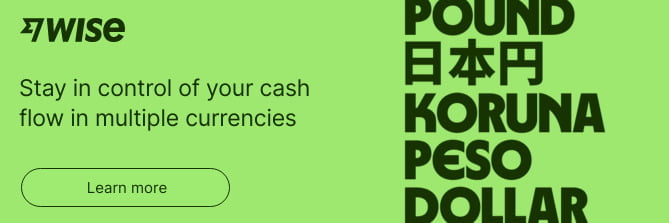Understanding your business cash flow and cash burn rate is essential for entrepreneurs. Without the capital to keep your business afloat, even the best ideas will fail. So it’s no wonder that 32% of founders were worried that they were spending too much cash¹. By better understanding your business finances, you can plan ahead and make smart decisions.
In this article, we'll define what cash burn really is, look at the different types of cash burn, and consider different strategies to help manage it.
Wise Business can help you optimise your cash flow and reduce unnecessary expenses by offering low-cost international transfers and multi-currency accounts.


What is cash burn?
A cash burn rate shows how quickly a startup is spending money before reaching a positive cash flow. It's a really helpful concept for early-stage startups who are still to turn a profit to consider how long their current funds will last before they need more capital investment. Potential investors may consider a startups cash burn rate when deciding whether or not to fund a venture.
Types of cash burn
Cash burn can take different forms. We'll take a few moments to define both gross and net cash burn to help bring clarity on what makes them distinct from each other.
1. Gross cash burn: unpacking total outflow
Gross cash burn rate tells you how much you’re spending each month, across the whole business. It’s the **entire amount **of cash going out of your business across a given period. This helps you know how much money you need to keep your doors open. It’s useful as it gives you an insight into your business’ cost drivers and efficiency, regardless of your revenue.
2. Net cash burn: accounting for incoming funds
On the other hand, a net cash burn rate measures your monthly spending after you’ve factored in your revenue. Put simply, it is your monthly revenue subtracted from monthly operating expenses, showing how much money your startup is losing each month. As it includes your revenue, your net cash burn rate tends to fluctuate more than your gross rate as the amount of money you’re making can change each month.
How to calculate cash burn rate
Understanding your cash burn rate and knowing how to calculate it can help you prepare for conversations with potential investors. Let's look at how you can work out the bottom line and that final key figure.
Calculating your gross cash burn rate
Calculating your gross cash burn rate is fairly straightforward. You simply add up all your expenses in a month. If you have annual expenses, you may want to add up your expenses for a year, and then divide them by 12.
Example
You own a gym. Each month you spend money on rent, electricity and heating. You also invest in new equipment every six months. Over the year, your expenses are as follows:
Rent: £500 per month = £6000 a year
Electricity: £250 per month = £3000 a year
Heating: £320 per month = £3840 a year
New equipment: £2000 every 6 months = £4000 a year
Total annual expenses = £6000 + £3000 + £3840 + £4000 = £16,840
Gross cash burn rate (annual) = Total annual expenses
Gross cash burn rate (annual) = £16,840
Gross cash burn rate (monthly) = Total annual expenses ÷ 12
Gross cash burn rate (monthly) = £16,840 ÷ 12
Gross cash burn rate (monthly) =£1,403.33
Calculating your net cash burn rate
Calculating your net cash burn rate is the same as your gross rate, plus an additional step. Once you’ve worked out your total expenses (your gross cash burn rate), you then subtract your revenue from it.
Example
As the gym owner, you’ve worked out that your total expenses for the year are £16,840. Your revenue is as follows:
Q1: £1500
Q2: £3500
Q3: £2750
Q4: £2500
Total revenue: £1500 + £3500 + £2750 + £2500 = £10,250
Net burn rate (annual) = Total annual expenses - Total annual revenue
Net burn rate (annual) = £16,840 - £10,250
Net burn rate (annual) = £6,590
Net burn rate (monthly) = (Total annual expenses - Total annual revenue) ÷ 12
Net burn rate (monthly) = £6,590 ÷ 12
Net burn rate (monthly) = £549.17
Factors influencing your cash burn rate
By looking at the different aspects which change the cash burn rate, whether positively or negatively, you can make strategic decisions accordingly to help your business take its next step.
1. Startup vs. established business cash burn
The stage you’re at in your business’ lifecycle will influence what affects your cash burn. Startups are particularly affected by their cash burn, with 29% of startups failing because they run out of money². As a result, startups need to consider:
- Business size: Typically, the larger the business, the higher the gross cash burn rate. This is because bigger businesses tend to have higher fixed costs and overheads such as a bigger business premises, more staff to employ, and more complex operations.
- Growth rate: How quickly your business is growing can also impact your burn rate. If you’re growing very quickly, your burn rate is likely to be higher as you’ll need to invest in new products or services or hire additional staff to help you manage the workload. In contrast, if you grow more slowly, you may have less expenses, or your revenue may increase at the same time as your need to spend more grows.
- Spending habits: If you spend more, your burn rate will be higher by default. Your startup may require a lot of staff or investment to get off the ground and thus have a higher burn rate.
- Revenue: The higher your income, the lower your net burn rate will be. When you get your product or service to market and how quickly customers adopt it will influence your revenue, and thus your burn rate.
- External factors: External factors like the wider economic situation, interest rates, and market conditions will also affect your net burn rate. If customers are spending less, your revenue will be lower. Alternatively, higher interest rates and supply chain uncertainty can mean you have to spend more money for the same result, pushing your expenses up.
Established businesses also need to consider a number of these factors, even if their burn rate tends to be more steady, with more stable expenses and revenue. Make sure to pay attention to inefficient spending as it’s easy to continue spending money on things that are no longer contributing to the growth of your business such as unused software or equipment.
2. Industry-Specific Cash Burn Trends
The industry that you’re operating in can also have an impact on your cash burn rate. This is because some industries require a large upfront investment in order to create a viable product or service. One person, service-based businesses, such as a freelance copywriter, tend to have relatively low cash burn rates as they have very few overheads, allowing them to achieve profit earlier.
In contrast, a tech startup can have quite a high burn rate due to needing to spend large amounts of money on research and development and customer acquisition. Biotechnology and pharmaceutical businesses also tend to have high burn rates due to regulatory costs and the necessity for clinical trials, with a burn rate potentially exceeding £150,000 per month³.
3. Operational efficiency and its impact on cash burn
Operational efficiency refers to the relationship between what a company is spending and the money coming in. The more efficient a company is, the lower the cash burn rate will be. You can make your operations more efficient by reducing your costs. You can begin this process by auditing your spending, making sure that you’re not spending money unnecessarily. This will decrease your burn rate without putting up prices.
How can startups manage and reduce cash burn
Now that we’ve established what cash burn is and the factors that influence it, we can look at how to manage it to keep your startup financially healthy. Here are some tips to help you control and reduce your cash burn.
Strategies for extending runway
Extending your runway means that you have more time before your cash runs out. You can calculate your cash runway by dividing your total cash by your net burn rate. A good runway to aim for is 24 to 36 months⁴.
Example:
The gym owner has £10,000 in their bank account.
Their monthly net burn rate is £549.17.
Their runway = £10,000 ÷ £549.17 = 18.2
The gym owner’s business can survive for 18 months under the current conditions.
You can extend your runway so that you have more time available by:
- Increasing revenue. By increasing the amount of money coming in, your net burn rate decreases. You could increase your revenue by releasing a new product or service, raising your prices, or selling more products.
- Reducing operating costs. Spending less will also lower your burn rate. You can try to reduce your costs by spending less on subscriptions, staffing, office space, and infrastructure costs.
- Raising capital. You can also extend runway by getting more investment from various startup funding platforms such as venture capital, loans, angel investors, and crowdfunding platforms.
Cost-cutting measures and their effectiveness
When done effectively, cost-cutting can increase your business’ profitability, improve your cash flow, and keep your cash burn rate down. However, when done poorly, cost-cutting measures can have a negative impact on staff morale, public reputation, and prevent future growth. Therefore, it’s quite a delicate line to walk. When cutting costs, you should focus on:
- Improving efficiency
- Optimising how you allocate resources
- Boosting profitability
- Fostering innovation
- Effective communication with staff around any changes to bring your team with you
Revenue generation and its role in mitigating cash burn
The alternative to cost-cutting is to generate more revenue. By increasing the amount of money coming in, your expenses are proportionately less. You can increase your revenue by increasing your sales, increasing prices, and retaining customers. As a result, your net cash burn will decrease, giving you more runway.
Considerations of high and low cash burn
Whether you have a high or low cash burn, these are some final aspects that you may want to consider.
1. Sustainability
A high burn rate indicates that a business is spending money quickly. This may prove to be unsustainable as the company may become bankrupt before they generate enough revenue. On the other hand, a low burn rate signals that the startup is spending money slowly. While this can be a positive, it may also indicate that a business isn’t spending strategically, preventing future growth. You may want to consider what the right balance for you and your business is.
2. Investor funding and challenges
When it comes to external investment, both types of burn rates can bring challenges. If an external investor, such as a venture capitalist, invests in you, they may well want to see a higher burn rate as they’ve given you the money to spend and know that higher investment can lead to higher growth. On the other hand, too high a burn rate can suggest reckless spending. A low burn rate can indicate stability, however, some investors may then have questions over the company’s potential to grow and its scalability.
3. Frugality vs. growth
Investing money in a business is often the key to stimulating growth. In fact, funding is now the top priority for entrepreneurial businesses preparing for acquisitions⁵. Therefore, a high burn rate can indicate this investment and commitment to growth. However, if the growth is too fast or the money invested hugely outstrips the pace of revenue increasing, the startup won’t survive. Keeping the goal of having 24 to 36 months⁴ of runway in mind will help you strike the right balance between frugality and growth.
Understanding and managing your cash burn rate as a startup is essential. By keeping an eye on the money coming in and out of your account, you can calculate how much money you need to spend every month and how long your business is viable for. By monitoring it closely, you can spend with confidence or scale back some months, depending on what the burn rate is telling you. It’s also important to get to grips with this if you’re seeking external investment as potential investors may question you on your burn rate.
Discover Wise Business to manage your business finances in multiple currencies


Wise Business can help you manage cash burn by offering international transfers at a mid-market exchange rate and multi-currency cards, reducing fees associated with traditional banking. This is also a particularly helpful feature if you pay for any product or services in a different currency. In addition, Wise Business has no monthly fees, so isn’t contributing to your expenses.
Get started with Wise Business ✍️
Sources used:
- Scale XP, SaaS Benchmarks 2023 Part 3: Cash Burn
- Silicon Valley Bank, Understanding what your startup’s burn rate really means
- Growth Equity Interview Guide, Burn rate: definition, calculation, and management
- Scaleup Finance, Managing cash burn during rapid growth: a Scaleup's guide to burn rate and financial health
- EY, How finance can empower your business to achieve its growth ambitions
Last accessed on 16-Oct 2025
*Please see terms of use and product availability for your region or visit Wise fees and pricing for the most up to date pricing and fee information.
This publication is provided for general information purposes and does not constitute legal, tax or other professional advice from Wise Payments Limited or its subsidiaries and its affiliates, and it is not intended as a substitute for obtaining advice from a financial advisor or any other professional.
We make no representations, warranties or guarantees, whether expressed or implied, that the content in the publication is accurate, complete or up to date.








